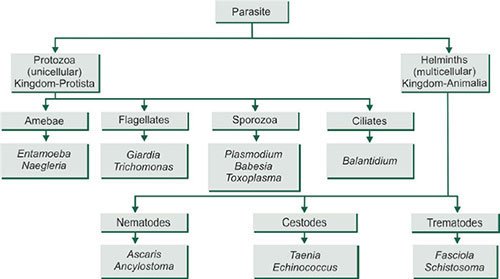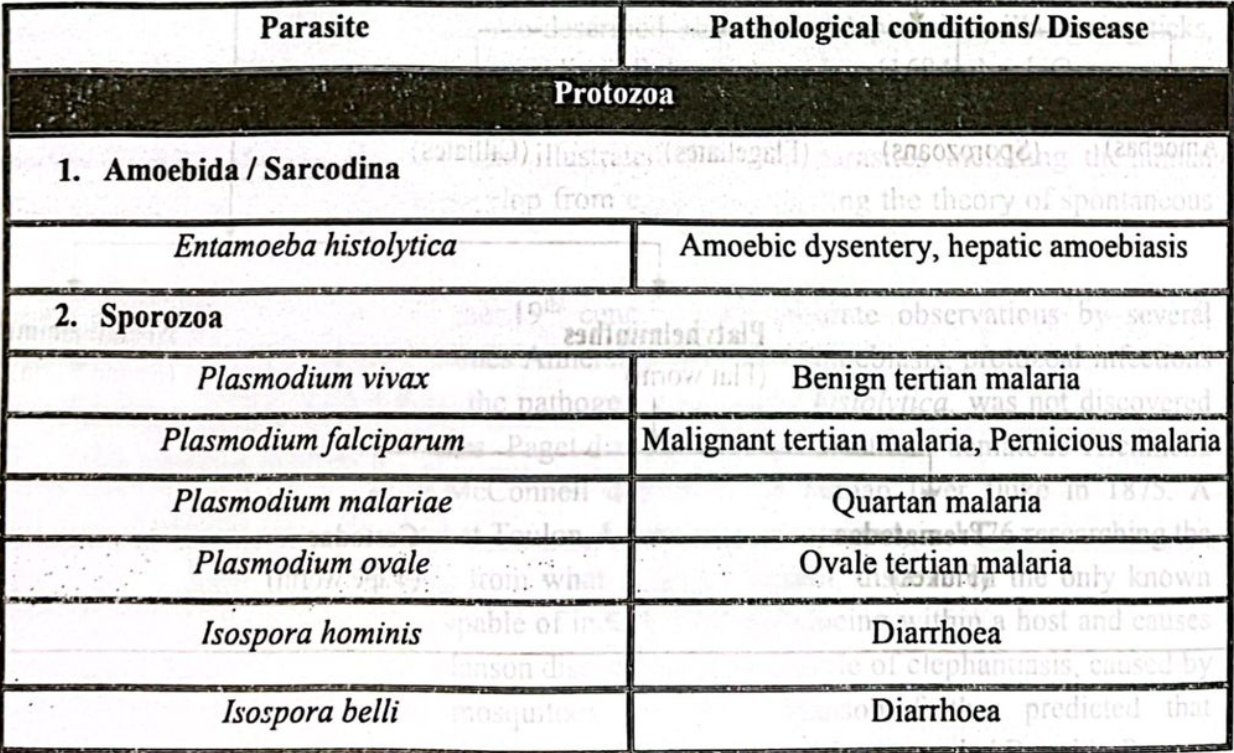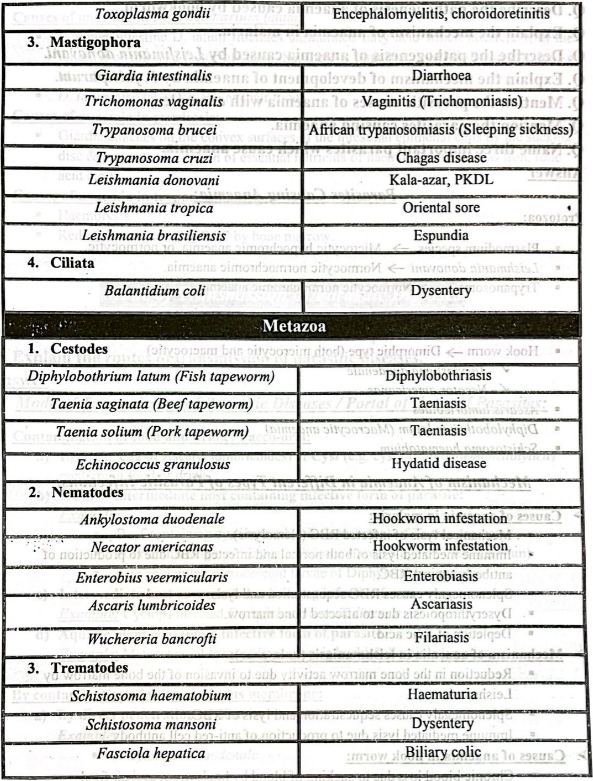Introduction to Parasitology – Basic microbiology, parasitology, and immunology; nature, reproduction, growth, and transmission of common microorganisms and parasites in Bangladesh; prevention including universal precaution and immunization, control, sterilization, and disinfection; and specimen collections and examination. Students will have an understanding of common organisms and parasites caused human diseases and acquire knowledge about the prevention and control of those organisms.
Introduction to Parasitology
It is a branch of biology which deals with the study of parasitism i.e. a phenomenon of dependence of one living organism on the other. In other words, Parasitology can also be defined as the study of parasites and their relationship to their host.
This discipline actually includes several approaches to the study of parasite and parasitism viz. ecological, taxonomical, morphological including histology and ultra- structures, biology including life cycles, host parasite relationship, pathological, physiological, chemotherapy, diagnosis including serological, immunological and other methods- nutritional, biochemical and biotechnology and other aspects of parasites.

Definition of Parasitology;
Parasitology is the study of parasites, their hosts, and the relationship between them.
Or
Parasitology may be defined as the branch of science that deals with parasites.
Definition of Medical Parasitology;
That branch of medical science which deals with the study of parasites of man and their medical consequences.
Definition of Parasite:
The term “parasite” came from the Greek “parasilos” (para, alongside of + silos, food) meaning “eating at the side of, or at the same table.”
or
Parasite can be defined as “A living organism which-depends on living organism for food and accommodation.” A parasite cannot live independently
Or,
Parasite can be defined as living organism which receives nourishment and shelter from another organism where it lives.
Common Parasitic Infection in Bangladesh
| Parasite | Vector | Parasitic disease. |
| Giardia intestinalis | House fly | Giardiasis |
| Entamoeba histolytica | House fly | Amoebiasis |
| Plasmodium species | Female anopheles mosquito | Malaria |
| Leishmania donovani | Sand fly | Kala-azar |
| Wuchereria bancrofti Brugia malayi | Female culex mosquito | Filariasis |
| Onchocerca volvulus | Female black fly | Onchocerciasis |
| Loa loa | Deer fly | Loiasis. |
Types of Parasites;
By definition parasitic organisms in the nature can be divided in many different classes –
| Agent | Cellular organization | Type of cell | Kingdom |
| 1. Helminthes | Multicellularw | Eukaryotic | Animal |
| 2. Protozoa | Unicellular | Eukaryotic | Protista |
| 3. Fungi | Uni/multicellular | Eukaryotic | Fungi |
| 4. Bacteria | Unicellular | Prokaryotic | Prokaryotae |
Some arthropods also cause some human infections but they remain outside the body and are considered as ectoparasites e.g. reduvid bugs, body louse.
However, conventionally helminthes and protozoa are called parasites.
Criteria of Parasitism:
Following are some of the important criteria for parasitism –
- Ecological relationship between two different organisms, one designated the parasite, the other the host.
- The parasite is physiologically or metabolically dependent upon its host.
- Heavily infected hosts may be killed by their parasites.
- The reproductive potential of the parasite exceeds that of their hosts.
History of Parasitology
Antonie van Leeuwenhoek observed and illustrated Giardia lamblia in 1681, and linked it to “his own loose stools”. This was the first protozoan parasite of humans that he recorded, and the first to be seen under a microscope.
A few years later, in 1687, the Italian biologists Giovanni Cosimo Bonomo and Diacinto Cestoni published that scabies is caused by the parasitic mite Sarcoptes scabiei, marking scabies as the first disease of humans with a known microscopic causative agent. In the same publication, Esperienze Intorno alla Generazione degl’Insetti (Experiences of the Generation of Insects), Francesco Redi also described ecto- and endoparasites, illustrating ticks, the larvae of nasal flies of deer, and sheep liver fluke.
His earlier (1684) book Osservazioni intorno agli animali viventi che si trovano negli animali viventi (Observations on Living Animals found in Living Animals) described and illustrated over 100 parasites including the human roundworm. He noted that parasites develop from eggs, contradicting the theory of spontaneous generation.
Modern parasitology developed in the 19th century with accurate observations by several researchers and clinicians. In 1828, James Annersley described amoebiasis, protozoal infections of the intestines and the liver, though the pathogen, Entamoeba histolytica, was not discovered until 1873 by Friedrich Lösch. James Paget discovered the intestinal nematode Trichinella spiralis in humans in 1835. James McConnell described the human liver fluke in 1875.
A physician at the French naval hospital at Toulon, Louis Alexis Normand, in 1876 researching the ailments of French soldiers returning from what is now Vietnam, discovered the only known helminth that, without treatment, is capable of indefinitely reproducing within a host and causes the disease strongyloidiasis. Patrick Manson discovered the life cycle of elephantiasis, caused by nematode worms transmitted by mosquitoes, in 1877.
Manson further predicted that the malaria parasite, Plasmodium, had a mosquito vector, and persuaded Ronald Ross to investigate. Ross confirmed that the prediction was correct in 1897-1898. At the same time, Giovanni Battista Grassi and others described the malaria parasite’s life cycle stages in Anopheles mosquitoes. Ross was controversially awarded the 1902 Nobel prize for his work, while Grassi was not.
Classification of Parasites
Types of Parasite:
A. According to Structure:

B. On the basis of site of infection:
a) Ectoparasite: e.g. lice (surface of host)
b) Endoparasite: e.g. malarial parasite (inside of body)
C. On the basis of period of infection:
a) Permanent: A lunbricoides in mm
b) Temporary: Larva of Cordylobia antropophaga
D. On the basis of pathogenicity:
a) Pathogenic: e.g. L. donovani (Harmful to man)
b) Commensal: e.g. Entamoeba coli (Normal flora)
Diseases Caused By Parasites
Pathological Conditions Caused By Each Parasite:


Parasites Causing Anaemia:
Protozoa:
Plasmodium species → Microcytic hypochromic anaemia, or normocytic.
Leishmania donovani → Normocytic normochromic anaemia.
Trypanosoma → Normocytic normochromic anaemia
Helminthes:
- Hook worm → Dimorphic type (both microcytic and macrocytic)
✓ Ancylostoma duodenale
✓ Necator americanas - Ascaris lumbricoides
- Diphylobothrium latum (Macrocytic anaemia)
- Schistosoma haematobium.
Mechanism of Anaemia in Different Types of Parasitic Infections:
➤ Causes of anaemia in malaria:
- Mechanical lysis of infected RBC (Hemolysis).
- Immune mediated lysis of both normal and infected RBC due to production of antibody against RBC.
- Splenomegaly causes RBC sequestration and lysis.
- Dyserythropoiesis due to affected bone marrow.
- Depletion of folic acid.
➤ Mechanism of anaemia in leishmaniasis (kala-azar):
- Reduction in the bone marrow activity due to invasion of the bone marrow by Leishmania.
- Splenomegaly causes sequestration and lysis of RBC.
- Immune mediated lysis due to production of anti-red cell antibody.
➤ Causes of anaemia in hook worm:
- Chronic blood loss due to sucking of blood by hook worm as their food.
- Nutritional deficiency.
➤ Causes of anaemia in Diphylobothrium latum:
- In upper intestine D. latum liberates unsaturated fatty acid which interfere with the function of intrinsic factor of castle. So, there is impairment of Vit-B12 absorption Megaloblastic anaemia.
- D. latum also takes Vit-B12 as their food.
➤ Causes of anaemia in giardiasis:
- Giardia attaches on the convex surfaces of the intestinal epithelial cells by the sucking disc & prevents absorption of essential nutrients of haemopoiesis (such as iron, folic acid etc.).
➤ Causes of anaemia in trypanosomiasis:
- Haemolysis
- Reduced production of RBC by bone marrow.
Mode of Transmission of Parasitic Diseases
Mode of Transmission of Parasitic Diseases / Portal of Entry of Parasites:
1. Contamination of food and drink / Faeco-oral:
a) Egg (e.g. egg of Ascaris lumbricoides) or Cyst (e.g. cyst of Entamoeba histolytica) containing food or drink.
b) Flesh of intermediate host containing infective form of parasite:
Example:
- Beef containing cysticercus bovis (larval stage of Taenia saginata)
- Pork containing cysticercus cellulosae (larval stage of Taenia solium)
- Fish containing plerocercoid larvae of Diphylobothrium latum.
c) Intermediate host as a whole harbouring infective form.
Example: Cyclops infected Diphylobothrium medinensis.
d) Aquatic plant containing infective form of parasite
Example: Metacercarial form of Fasciolopsis buski & Fasciola hepatica
2. By contamination of skin or mucous membrane:
a) By direct penetration of skin:
Example:
- Ancylostoma duodenale
- Necator americanas
- Strngyloides stercoralis
- Schistosoma haematobium
- Schistosoma mansoni
- Schistosoma japonicum
b) By blood sucking arthropods:
Example:
- Plasmodium species
- Wuchereria
- Leishmania species
- Trypanosoma
c) By inhalation of dust containing egg:
Example:
- Ascaris lumbricoides
- Enterobius vermicularis
d) By blood transfusion: e.g. plasmodium species.
e) By sexual contact: e.g. Trichomoniasis.
f) Trans-placental/congenital
Example:
- Toxoplasma gondii
- Plasmodium.
3. By vector or insects:
Example:
- Leishmania donovani.
- Plasmodium species.

Diagnosis of Parasitic Diseases
Outline on Diagnosis of Parasitic Diseases:
Direct evidence:
a) Intestinal parasites: Examination of stool, rectal and anal material, intestinal content by intubation – Microscopic examination.
b) Haemoparasites: Examination of blood by preparing stained smear e.g. Malaria, Leishmania, Trypanosoma.
c) Tissue parasites: Biopsy and microscopic examination.
d) Genome detection.
Indirect evidence:
a) Blood cell count from blood film.
b) Serology detection of antigen & antibody.
Parasites Detected by Immunological Test:
| Entamoeba histolytica | Precipitin test, CFT (complement fixation test) |
| Echinococcus granulosus | Precipitin test, CFT |
| Wuchereria bancrofti | CFT |
| Leishmania donovani | CFT + agglutination test |
| Trichenella spiralis | CFT |
| Brugia malayi | CFT |
| Schistosomiasis | CFT + precipitin test. |
Parasites can be diagnosed by examination of blood:
| Parasites | Disease |
| Malaria parasite | Malaria |
| Leishmania donovani | Kala-azar (visceral leishmaniasis) |
| Wuchereria bancrofti | Filariasis |
| Brugia malayi | Malayan filariasis |
| Trypanosoma brucei | Trypanosomiasis |
| Babesia microti | Babesiosis |
Read More….
